The two 15th century chantries that flank the shrine of St Swithun at Winchester are an exuberant expression of stone masons’ skills at the height of Perpendicular architecture.
| Years as Bishop | Location of Chantry | ||
| 1 | Cardinal Henry Beaufort | 1405-1447 | S side of later position of St Swithin Shrine |
| 2 | William Waynflete | 1447-1486 | N side of later position of St Swithin Shrine |

At Winchester Cathedral the 15th C cage chantries of Bishop Henry Beaufort’s and Bishop Waynflete’s are contemporary structures, placed either side of the new shrine to St Swithun (completed 1476). They made use of Purbeck Stone, which Henry of Blois and brought in some 300 years earlier. These chantries were the last cathedral structures at Winchester to make use of the polished Purbeck Stone.[i]
15th Century: Bishop Waynflete’s Application: Two Chantries with Soaring Pinnacles & Expressive Vaulting flanking the new Shrine of St Swithun.
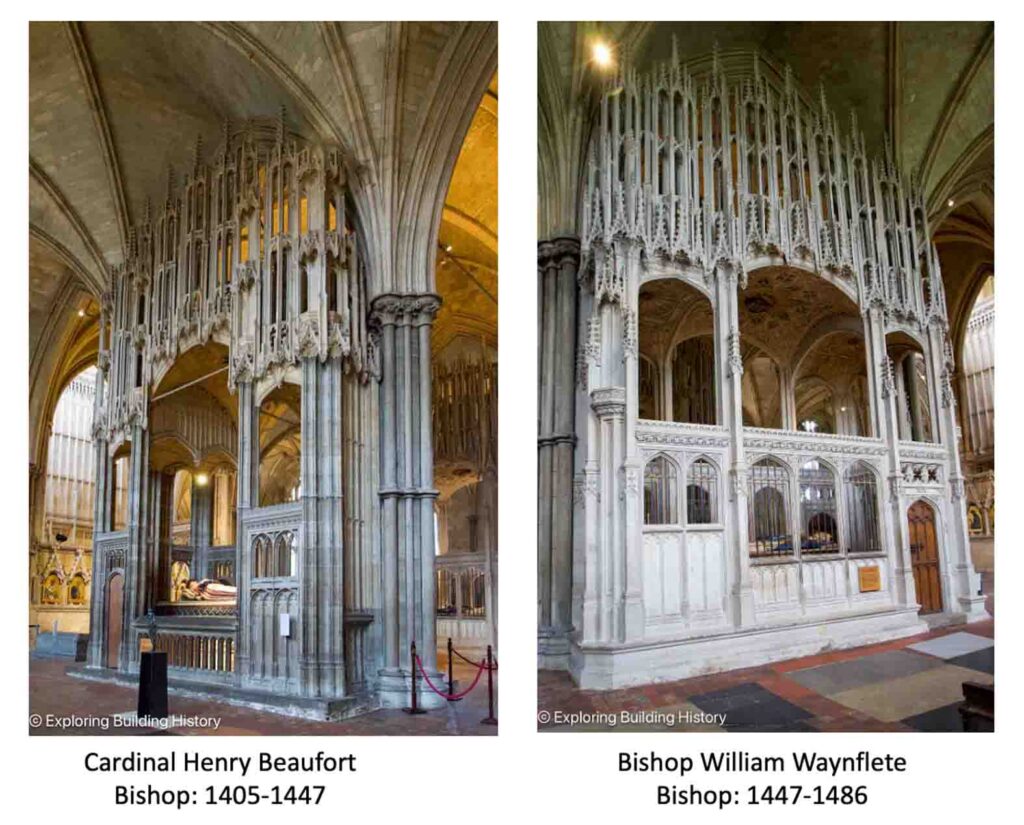
The chantries are masterpieces of the height of Perpendicular articulation. The effigies are accessible to the viewer from the exterior, which the later chantries of Bishops Fox and Gardiner are not. These latter chantries also house the cadaver memento mori of the bishops. Beaufort and Waynflete’s chantries are exuberant, ensuring that pilgrims to the shrine of St Swithun don’t miss them, their status and the sophisticated expression of micro architecture of the latter part of the 15th Century.
Cardinal Henry Beaufort was able to provide the funding for architectural projects such as his chantry, likely the great screen and the new shrine for St Swithun. It would be his successor Bishop Waynflete who brought these three projects to fruition. Beaufort completed the nave started by his predecessors.[ii]
In Somerset the latter part of the 15th Century and early 16th Century saw building works on church towers to rise them up in the new style of Perpendicular architecture. It had been initiated at Gloucester Cathedral, whose new tower was built in the 1450s. The concept of having bar tracery, pinnacles, open work, all added to a soaring upwards and a lighter articulation of stone.
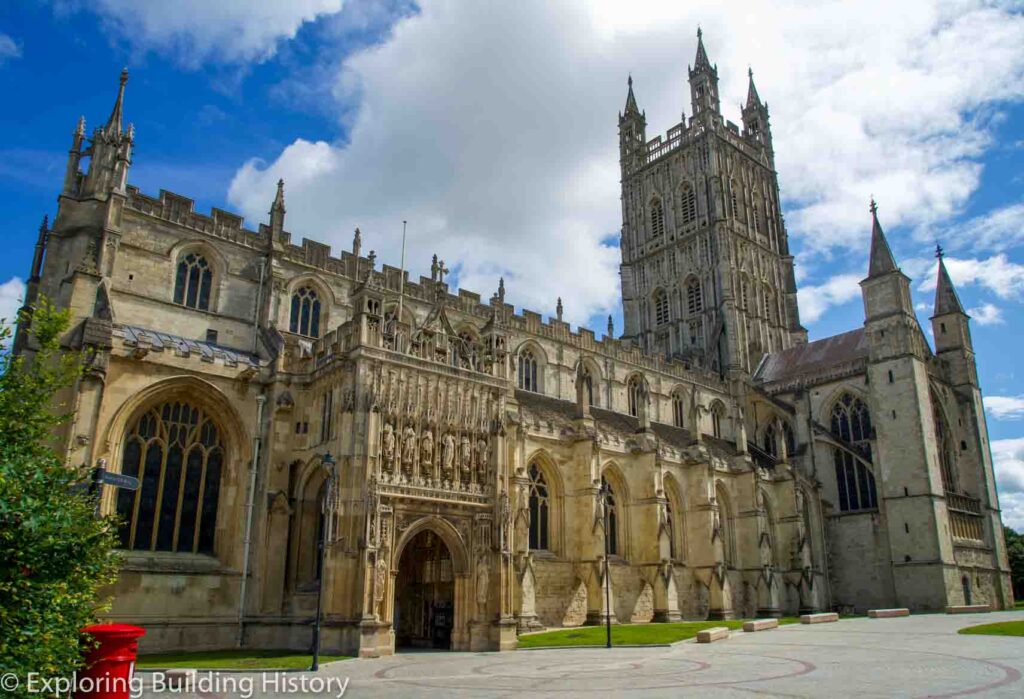
Gloucester Cathedral: Perpendicular Tower dates from the 1450s

Upper section of the tower of Taunton Minster (Church of St Mary Magdalene), circa 1503
Bishop (Cardinal) Henry Beaufort (Bishop from 1405 to 1447)
Henry Beaufort was the son of John of Gaunt, duke of Lancaster and Katherine Swynford. Whilst an illegitimate son he was able to find his place at court and in politics. He was a wealthy and power magnate in 15th C England, and has been described as a precursor to Cardinal Wolsey, and presented by Shakespeare in his Henry VI plays as ‘haughty, avaricious, and worldly prelate’.[iii] The reality is likely a more complex statesman dealing with the political conditions of his time.[iv]
Pope Martin V (r. 1417-31) appointed him cardinal and legate a latere (highest rank of papal legate – i.e. a cardinal who has the right to represent the pope, as if he was the pope himself). Pope Martin allowed Beaufort to retain the see of Winchester in commendam (a benefice in trust which entitled him to the revenues) and be exempt from the jurisdiction of Canterbury whilst he was bishop.[v] This was a powerful position with the benefits of a wealthy see.
Beaufort was bishop under 3 kings of England: Henry IV (r. 1399-1413), Henry V (r. 1413-1422), and Henry VI (r. 1422-1471). He was present at the trial of Joan of Arc.
He was known as the ‘Rich Cardinal’, often lending to the crown. He also carried the title ‘cardinal of England’ and his effigy in his chantry demonstrates his pride of this rank (Thomas Wolsey was the last to cardinal to hold this title). He cited in his will that 10,000 masses be said for his soul and that his tomb and chantry be sited next to the tomb of St Swithun at Winchester.[vi]
A portrait of a cardinal painted by the Flemish artist Jan van Eyck (d. 1441) may well be Henry Beaufort, making it the earliest realistic portrait of an Englishman.[vii] This trend of realism in art heralds the Northern European Renaissance. With humanistic philosophies, growth in trade and commerce, greater education opportunities, ideas in art, architecture and literature, etc., a new type of society in England was emerging.
Able men could take advantage of openings and perform functions in administration, the law, clerical work, etc. This had been the case for Bishop Edington and Bishop Wykeham in the 14th C. Men from less privileged backgrounds with talent could acquire patrons and gain an education at Oxford or Cambridge. Bishop Waynflete, Cardinal Beaufort’s successor was such a man, the latter being his patron.[viii] Whilst Waynflete was from gentry stock he needed patronage to acquire his status. It would follow that able men like Thomas Wolsey (c. 1470 – 1530) and Thomas Cromwell (c. 1485 – 1540) from humble backgrounds could take advantage of education, openings and patronage to make their way in the world and dominate the English political stage.
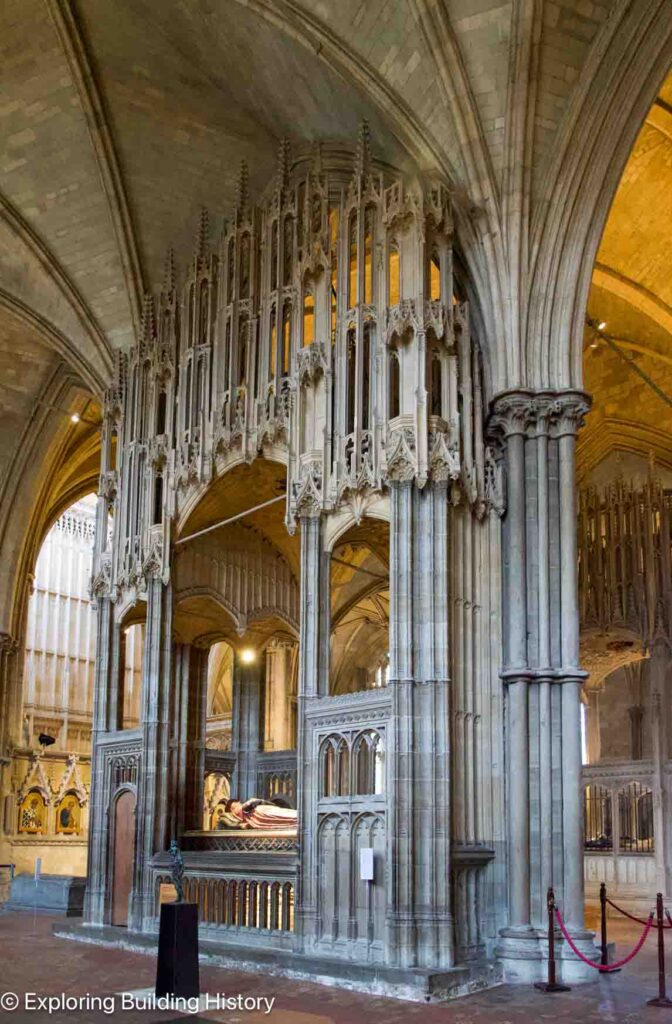
Cardinal Henry Beaufort’s Chantry (d. 1447)
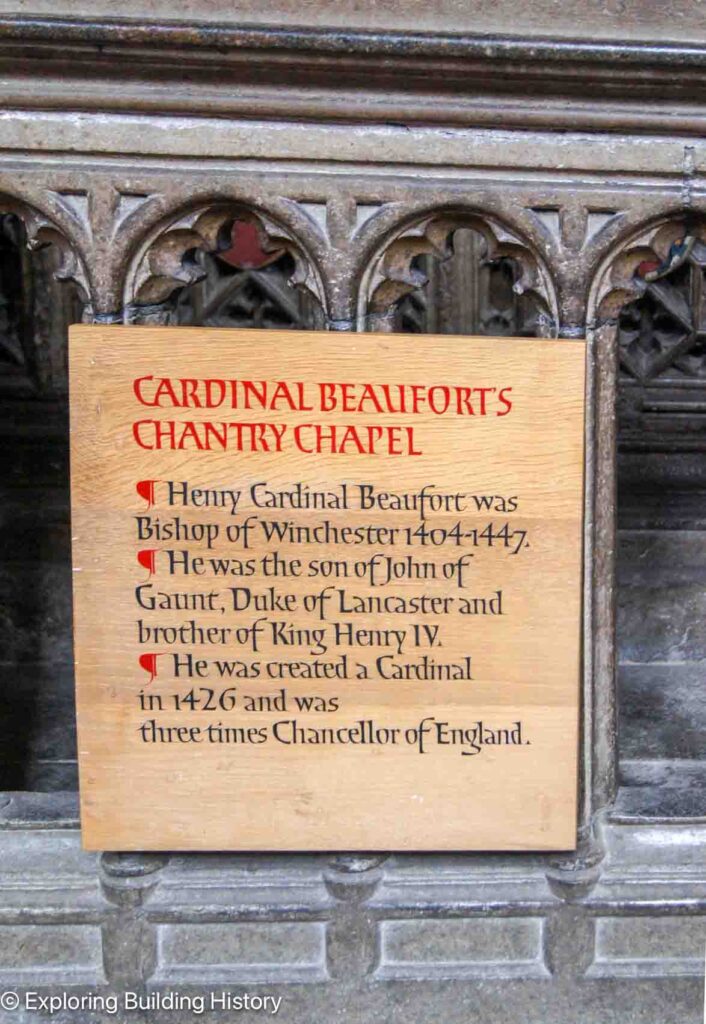
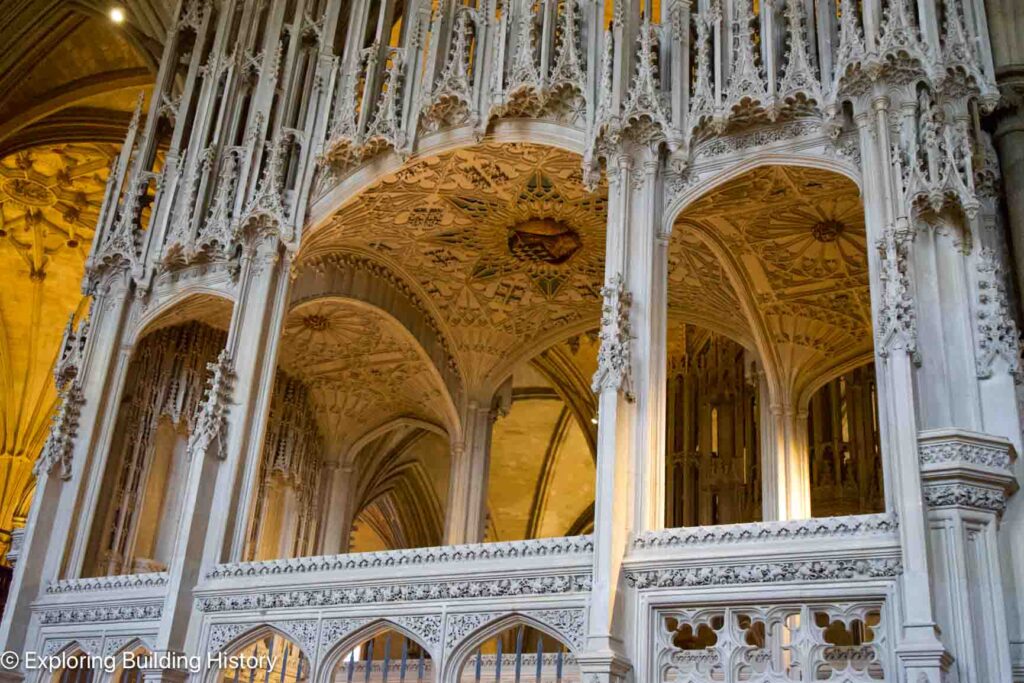
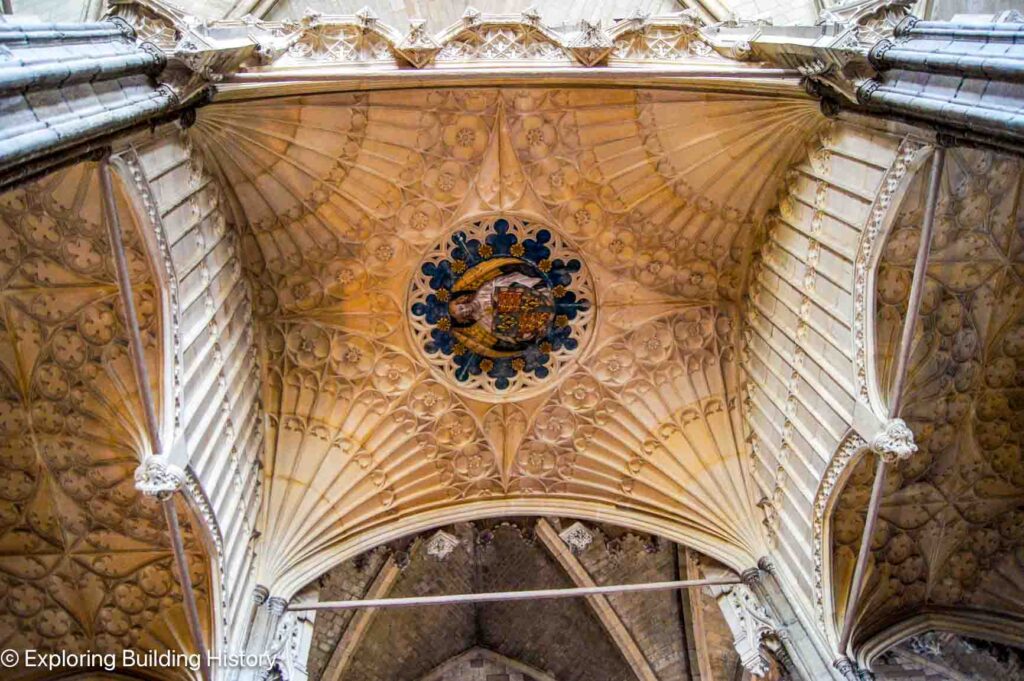
Beautiful fan vaulting within the chantry
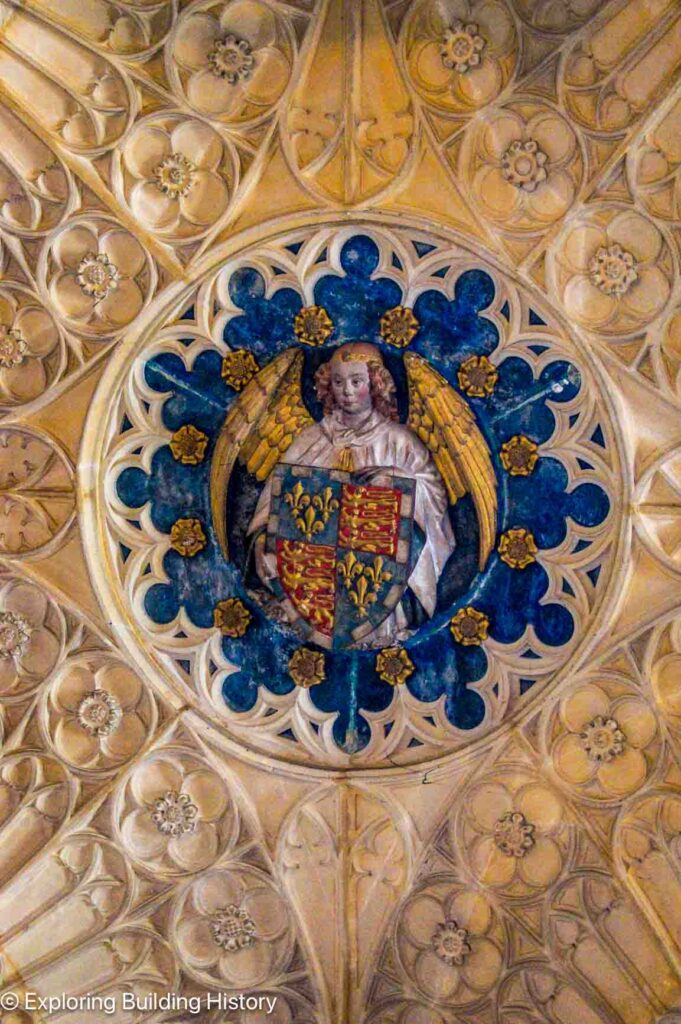
The angel bears the Royal Arms of England with the Fleur de Lys, representing Edward III’s claim to the French throne

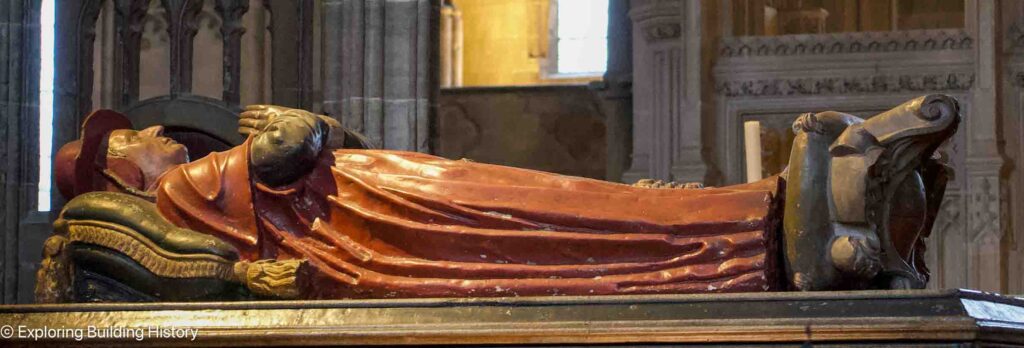
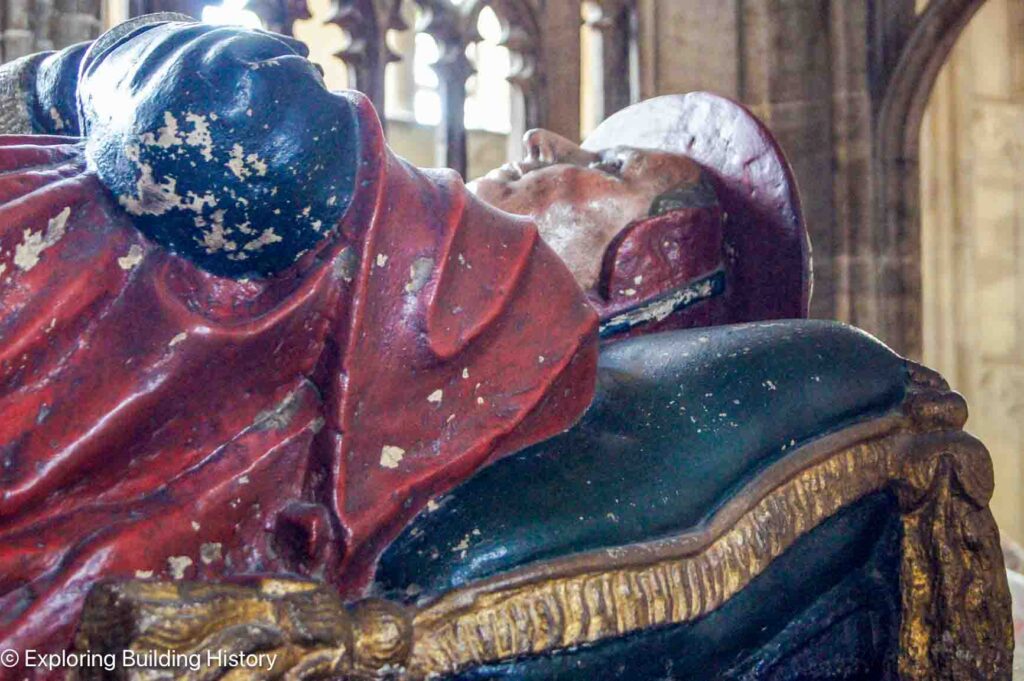
Bishop Henry Beaufort’s effigy, reclining on a fringed and tasselled cushion wearing his cardinal’s robes.
Bishop William Waynflete (Bishop from 1447 to 1486)
Bishop Waynflete built the twin chantries for himself and Bishop Henry Beaufort, either side of the new shrine of St Swithun. Both chantries have soaring pinnacles and fan-vaulted ceilings. They also make sure the external viewer can see the effigies easily of the bishops. Both these chantries embody the sophistication of the architectural height of the Perpendicular. Bishop Waynflete was a bishop of progressive interests who surrounded himself with those embracing humanistic ideas and studies. The chantries are an expression of an exciting period of the early modern foundation.
William Waynflete, from gentry stock, had a significant interest in education. He was consecrated as bishop in the incomplete chapel of Eton College on the 30th of July 1447. He oversaw the completion of this chapel. It had been his appointment at Eton College that brought him into the orbit of Henry VI, who would recommend him as Beaufort’s successor as bishop of Winchester.[ix]
As bishop he created the new shrine of St Swithun and the saint’s bones were translated in 1476, with Waynflete present. Waynflete was an able administrator and implemented several innovations in estate management. He appointed a professional auditor from 1448, and in 1453 he changed the accounts from pipe rolls into book form, which made it easier to consult the accounts. His annual estate income was over £4000.[x] This would be around £4 million today.[xi]
Waynflete was a patron of education, particular the teaching of grammar. He founded Magdalen College, Oxford. He was an important figure in English humanistic thinking with an extensive library. He was patron of publications and bookbinding.[xii]
The revolution of the printing press in the early 1480s promulgated grammar teaching, partly based on books by contemporary Italian grammarians. He established grammar schools and extended the episcopal palaces at Farham and Esher. He is likely the builder of the great screen at the cathedral. He had a key role in the dissemination of the use of brick in southern England. This would influence the later use of brick in domestic architecture.[xiii]
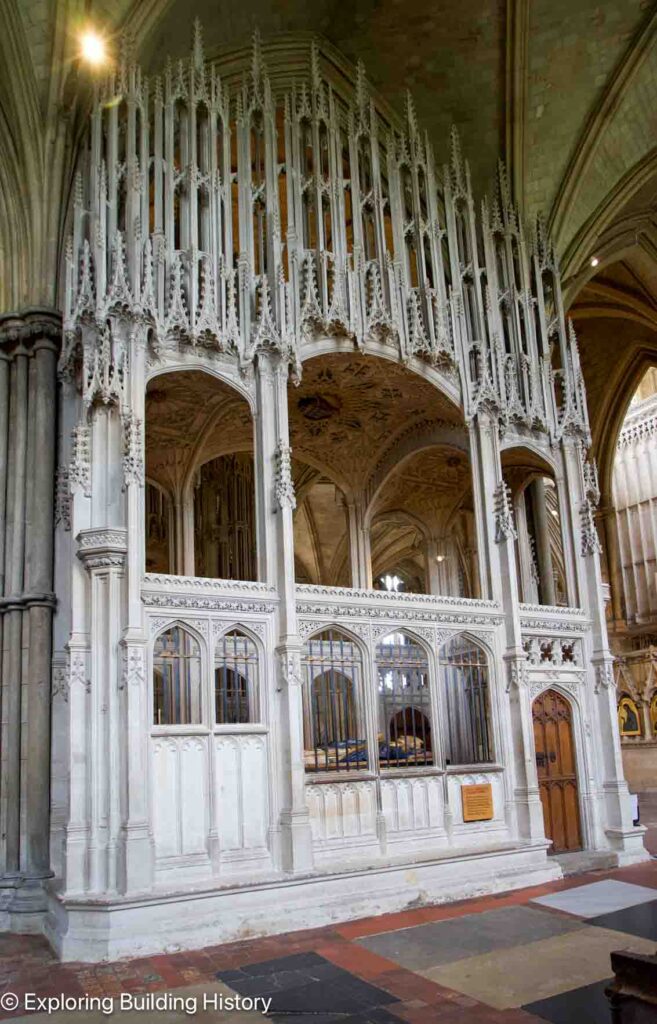
Bishop William Waynflete’s (d 1486) Chantry. He died soon after the completion of the new shrine for St Swithun

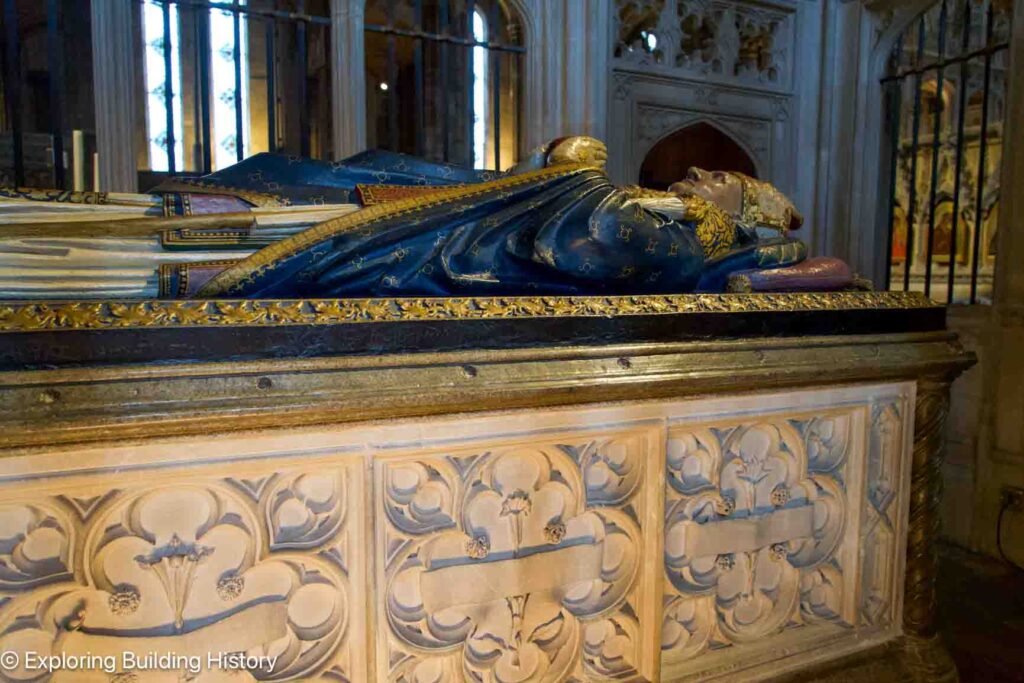
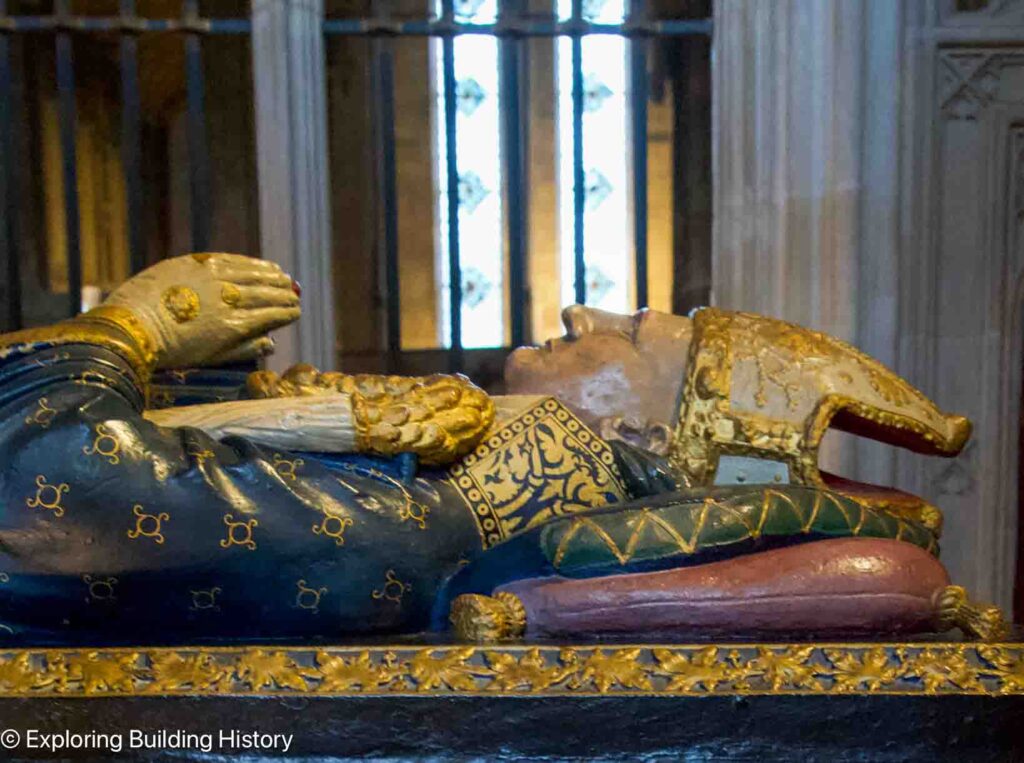
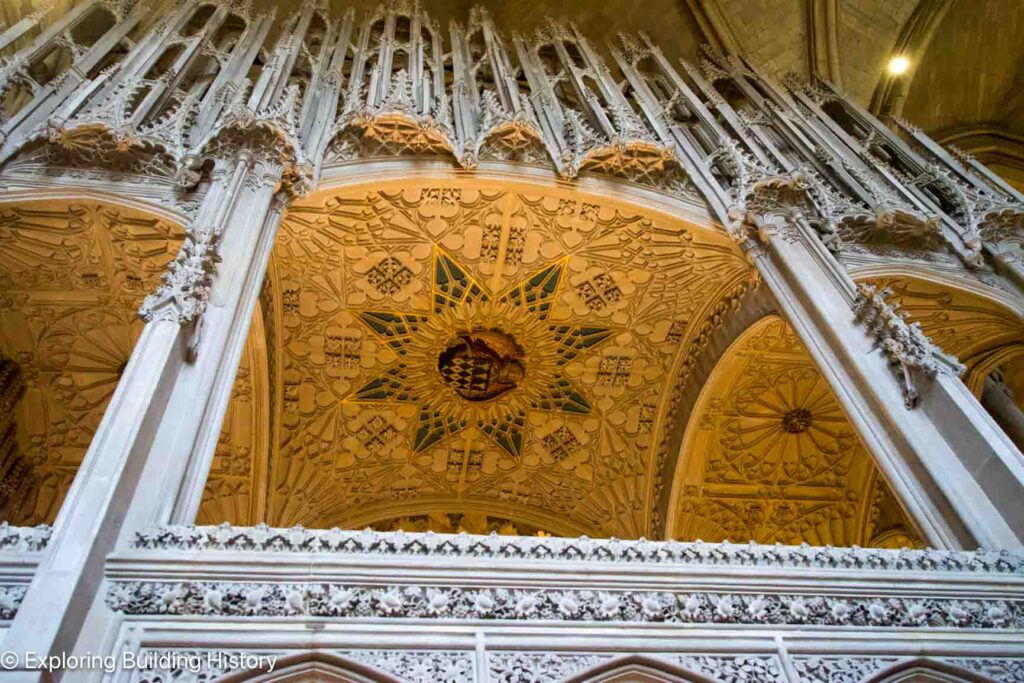
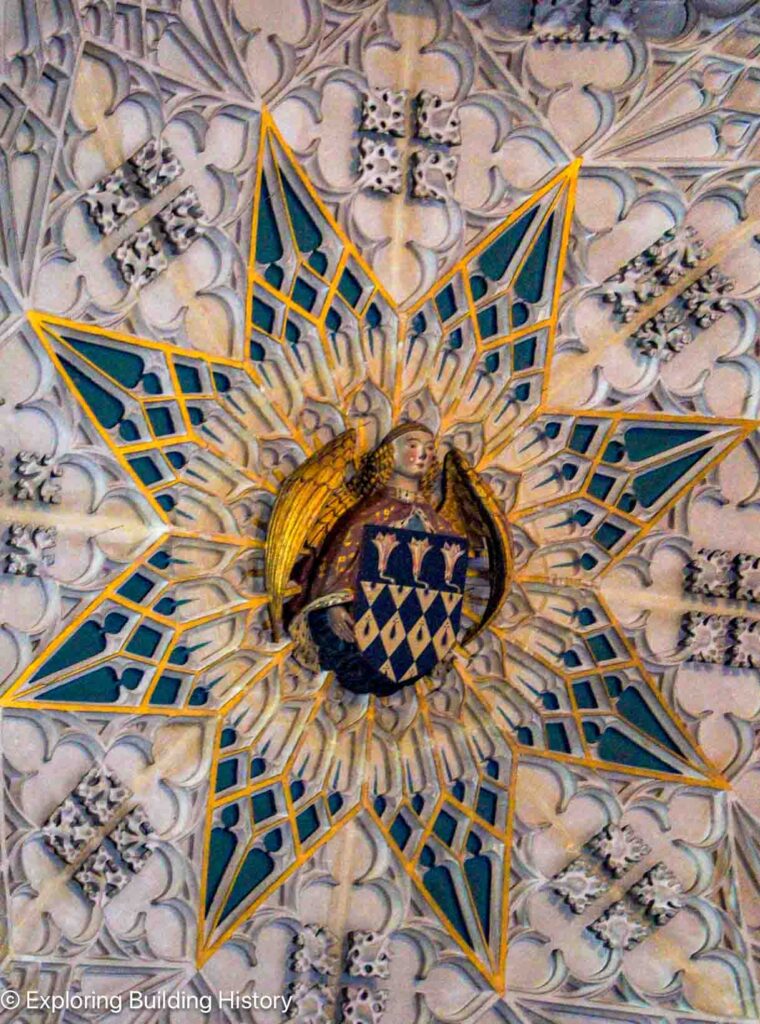
The arms, including lilies drawn from the arms of Eton College.[xiv]
THE PERPENDICULAR ARISING FROM GLOUCESTER CATHEDRAL
Cage chantries have echoes of the much earlier tomb monument of Edward II at Gloucester. It was commissioned by his son, Edward III, in the 1330s.[xv] Whist not a chantry (it is not a small chapel structure with an altar and room for a priest), it’s cage-like structure is of a Perpendicular design.
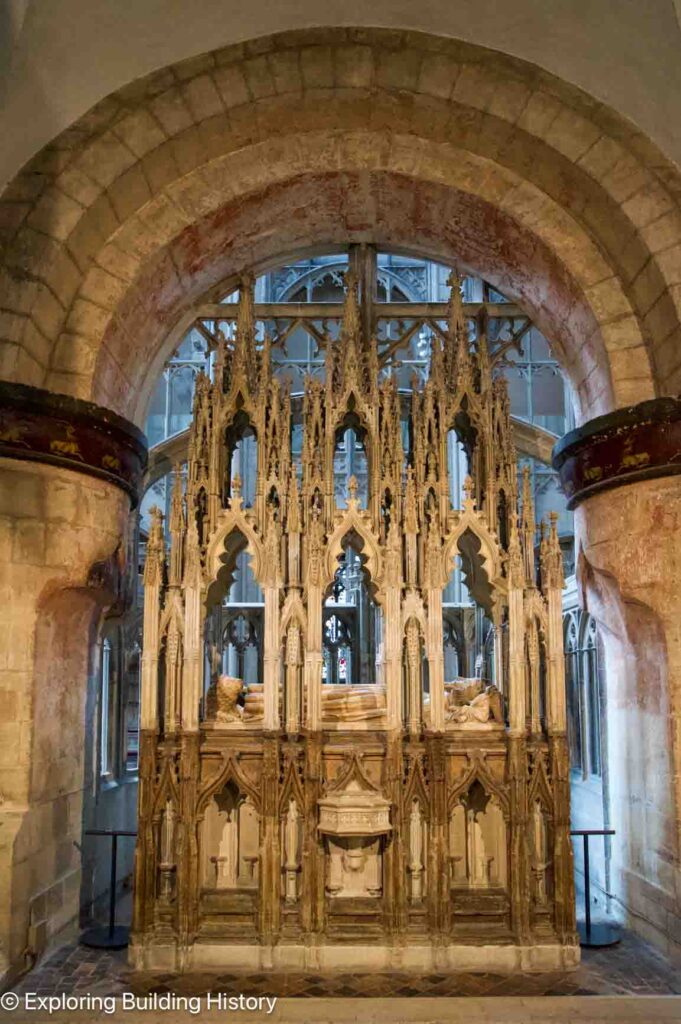
Tomb Monument of Edward II at Gloucester Cathedral, circa 1330s
The monument is sited under a Norman arch and between two arcade piers. It was built by Edward III for his father. The royal masons were able to translate the innovation. Master Mason, William Ramsey (fl. 1323-1349), was a pioneer of the English Perpendicular style. He worked at Gloucester, Canterbury, Westminster Abbey and Old Saint Paul’s.
Whilst this monument is earlier than the cage chantries at Winchester, it is likely that design ideas were developed by royal masons and others who had seen this structure at Gloucester.

Detail of Edward II’s tomb – grotesques are carved at the terminals of the pinnacles. Later pinnacles will be dotted with crockets and no grotesques.
Another innovation at Gloucester was the fan vaulting in the cloisters. This was complete by 1412.[xvi]Possibly the earliest fan vaulting was created in the chantry of Edward, Lord Despenser (d. 1375) at Tewkesbury Abbey in Gloucestershire. It is likely the mason working on this chantry took his skills to Gloucester Cathedral which is twelve miles away.[xvii] The chantry of The Winchester chantries of Cardinal Beaufort and Bishop Waynflete employ a delicate interpretation of the innovation of fan vaulting.
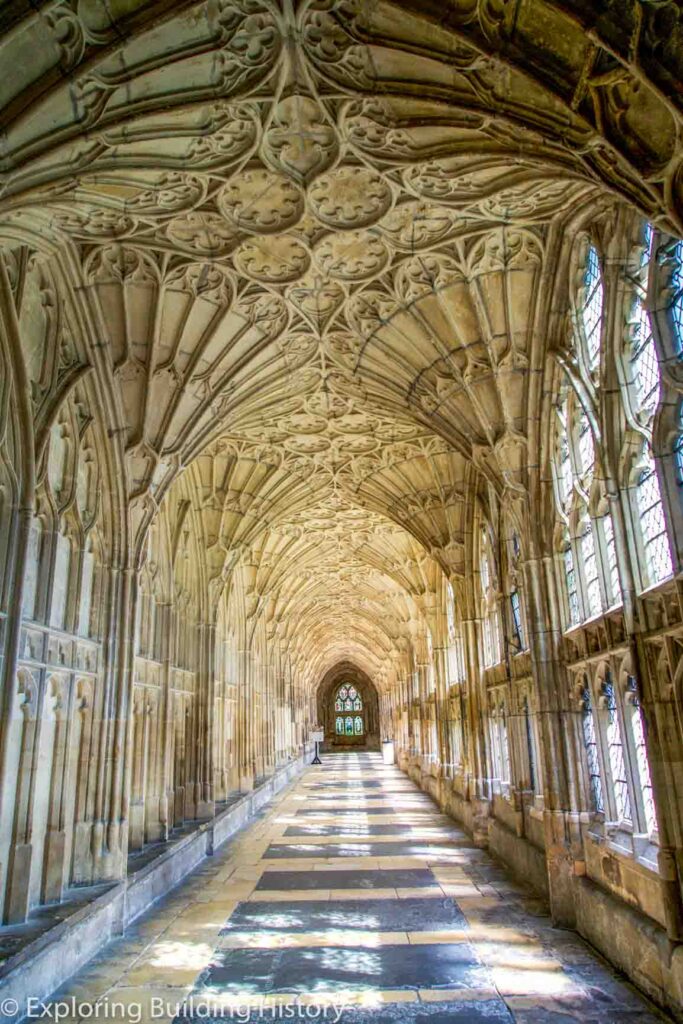
Cloisters at Gloucester Cathedral, completed by 1412
FOR MORE INFORMATION ON CHANTRIES CLICK https://www.exploringbuildinghistory.co.uk/grand-tour-of-winchester-part-vii-200-years-of-the-cage-chantry/
NOTES
[i] Jon Cannon, The Great English Cathedrals and the world that made them (Constable: London, 2007; repr. 2011), p. 448.
[ii] Cannon, p. 448.
[iii] G. L. Harriss, “Beaufort, Henry [called the Cardinal of England] (1375?–1447), bishop of Winchester and cardinal.” Oxford Dictionary of National Biography. 23 Sep. 2004, <https://www.oxforddnb.com/view/10.1093/ref:odnb/9780198614128.001.0001/odnb-9780198614128-e-1859> [accessed 29 August 2025].
[iv] G. L., Harriss, “Beaufort, Henry [called the Cardinal of England] (1375?–1447), bishop of Winchester and cardinal.” Oxford Dictionary of National Biography.
[v] G. L., Harriss, “Beaufort, Henry [called the Cardinal of England] (1375?–1447), bishop of Winchester and cardinal.” Oxford Dictionary of National Biography.
[vi] G. L. Harriss, “Beaufort, Henry [called the Cardinal of England] (1375?–1447), bishop of Winchester and cardinal.” Oxford Dictionary of National Biography.
[vii] G. L. Harriss, “Beaufort, Henry [called the Cardinal of England] (1375?–1447), bishop of Winchester and cardinal.” Oxford Dictionary of National Biography.
[viii] Virginia, Davis, “Waynflete [Wainfleet, Patten], William (c. 1400–1486), bishop of Winchester and founder of Magdalen College, Oxford.” Oxford Dictionary of National Biography. 23 Sep. 2004, Acces<https://www.oxforddnb.com/view/10.1093/ref:odnb/9780198614128.001.0001/odnb-9780198614128-e-28907[accessed 29 August 2025].
[ix] Virginia, Davis, “Waynflete [Wainfleet, Patten], William (c. 1400–1486), bishop of Winchester and founder of Magdalen College, Oxford.” Oxford Dictionary of National Biography.
[x] Virginia, Davis, “Waynflete [Wainfleet, Patten], William (c. 1400–1486), bishop of Winchester and founder of Magdalen College, Oxford.” Oxford Dictionary of National Biography.
[xi] ‘Inflation Calculator’, Bank of England < https://www.bankofengland.co.uk/monetary-policy/inflation/inflation-calculator> [accessed 27 August 2025].
[xii] Virginia, Davis, “Waynflete [Wainfleet, Patten], William (c. 1400–1486), bishop of Winchester and founder of Magdalen College, Oxford.” Oxford Dictionary of National Biography.
[xiii] Virginia, Davis, “Waynflete [Wainfleet, Patten], William (c. 1400–1486), bishop of Winchester and founder of Magdalen College, Oxford.” Oxford Dictionary of National Biography.
[xiv] Virginia, Davis, “Waynflete [Wainfleet, Patten], William (c. 1400–1486), bishop of Winchester and founder of Magdalen College, Oxford.” Oxford Dictionary of National Biography.
[xv] Cannon, pp. 342-343.
[xvi] Stephen Friar, The Companion to Cathedrals & Abbeys (Stroud: The History Press, 2010; repr. 2011), p. 394.
[xvii] Friar, p. 394.
BIBLIOGRAPHY
Cannon, Jon, The Great English Cathedrals and the world that made them (Constable: London, 2007; repr. 2011)
Davis, Virginia, “Waynflete [Wainfleet, Patten], William (c. 1400–1486), bishop of Winchester and founder of Magdalen College, Oxford.” Oxford Dictionary of National Biography. 23 Sep. 2004, Acces<https://www.oxforddnb.com/view/10.1093/ref:odnb/9780198614128.001.0001/odnb-9780198614128-e-28907 [accessed 29 August 2025]
Friar, Stephen, The Companion to Cathedrals & Abbeys (Stroud: The History Press, 2010; repr. 2011)
Harriss, G.L., “Beaufort, Henry [called the Cardinal of England] (1375?–1447), bishop of Winchester and cardinal.” Oxford Dictionary of National Biography. 23 Sep. 2004, <https://www.oxforddnb.com/view/10.1093/ref:odnb/9780198614128.001.0001/odnb-9780198614128-e-1859> [accessed 29 August 2025]

